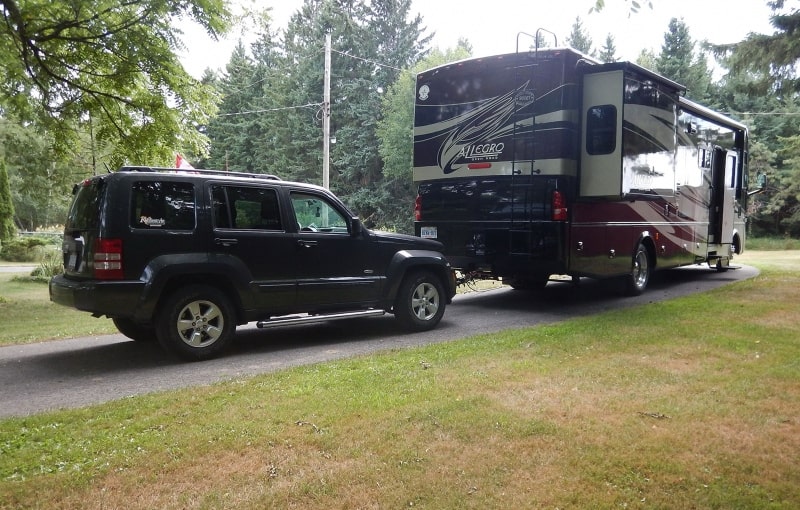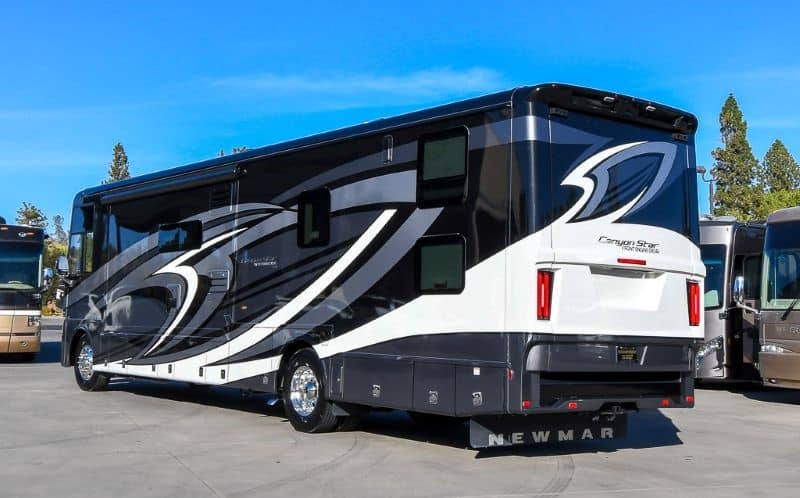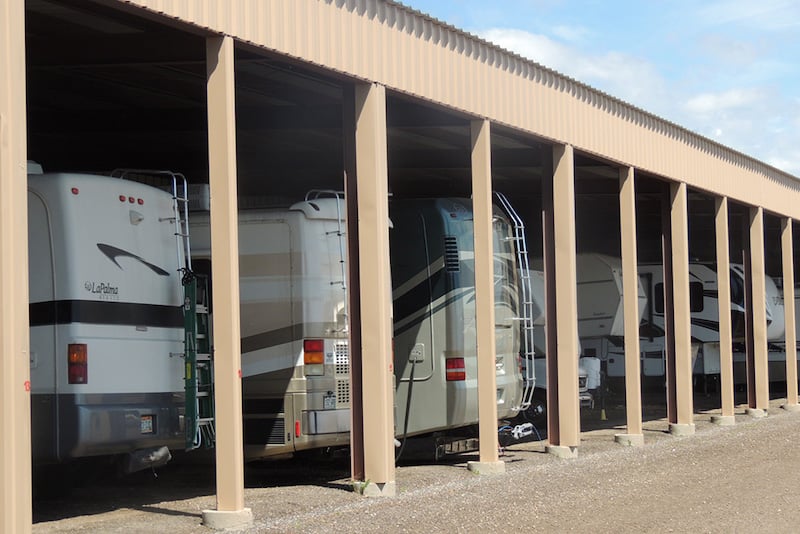A Class A Motorhome with tow capacities at the highest levels are the behemoths of the Class A category. They run between 40’ and 45’ in length; some are large enough to ride on three axles. But How much can a Class A Motorhome tow?
They’re the home away from home, with manufacturers somehow finding ways to cram the pinnacle of luxury, refinement, and space into a moving vehicle that would put a single wide trailer—and some double wides—to shame.
With as large as they are, there are two ways of looking at things in terms of how much they can tow. The first is that these massive juggernaut Class A motorhome tow capacities should be able to haul a line of tanks. The second is that they are so big they can’t afford the additional weight.
What’s the Average Towing Capacity of a Class A RV?
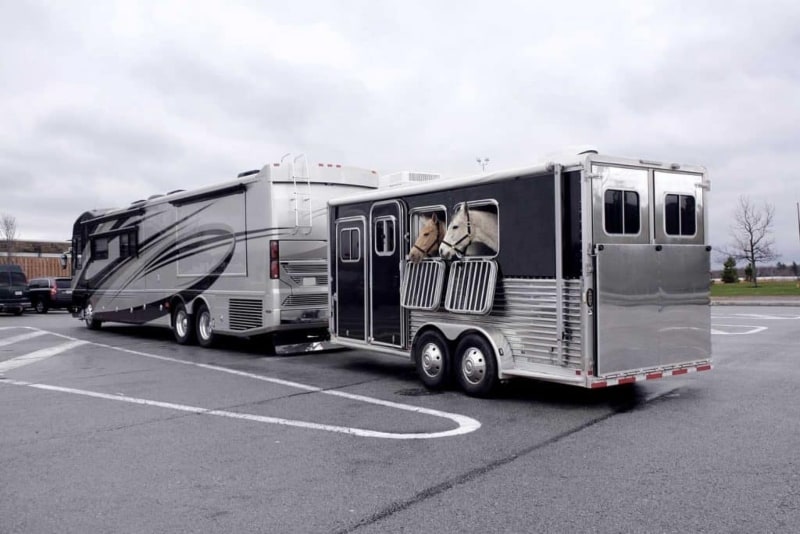
Most Class A Motorhomes come with a towing capacity of anywhere between 5,000 lbs and 10,000 lbs. Some can only muster up enough to haul an additional 5,000 lbs, while others can haul 20,000 lbs. It just depends on the Class A Motorhome.
The American Coach Eagle 45K can tow up to 20,000 lbs, but this Gigantor has a mind-numbing 66,000 lb GCWR (Gross Combined Weight Rating). The Thor Motor Coach Tuscany 40RT and the Forest River Berkshire XLT 45A can tow 15,000 lbs.
How Do You Determine the Towing Capacity of a Motorhome?
Ah, math. You hate it every day you go through high school thinking, “When am I ever going to use this in real life?” Then the day comes when you have to calculate the real towing capacity of your Class A Motorhome. We promise you don’t need a background in trigonometry to figure it out.
What you do need is a few numbers. Typically, it’s the difference between your GCWR and GVWR (Gross Vehicle Weight Rating). However, things fluctuate when you start throwing stuff in storage and have all of your passengers aboard.
- GVWR is found on the tire pressure plate (usually inside the driver-side door)
- GCWR is found on your chassis specs
- OCCC is the Occupant and Cargo Carrying Capacity, usually found in the driver-side door as well (or CCC)
- Get the weight of your empty RV by subtracting OCCC from GVWR (a.k.a. UVW or dry weight, which may already be on the label)
- Take the weight of your empty RV (UVW) and add the weight of the vehicle you want to tow, the combined passenger weight, all of the passenger weights, and all of the water weight from every water tank
- Add the weight of additional gear in storage, propane tanks, and essentially anything extra you bring on the motorhome
UVW+ passenger weight+water weight+gear+propane+extra= Actual Gross Vehicle Weight (>GVWR)
Actual Gross Vehicle Weight+towed vehicle= Gross Combined Weight (>GCWR)
If the above-combined weight exceeds your GCWR, you are overweight, even if the vehicle you want to tow weighs less than your hitch rating. Let’s say you have a hitch rating of 5,000 lbs.
If you weigh your fully loaded motorhome, including all of the passengers and the difference between all this weight and your GCWR is only 2,578 lbs, then 2,578 lbs is your actual tongue/hitch weight. In other words, you’re good.
7 Factors That Affect Your Motorhome’s Tow Capacity
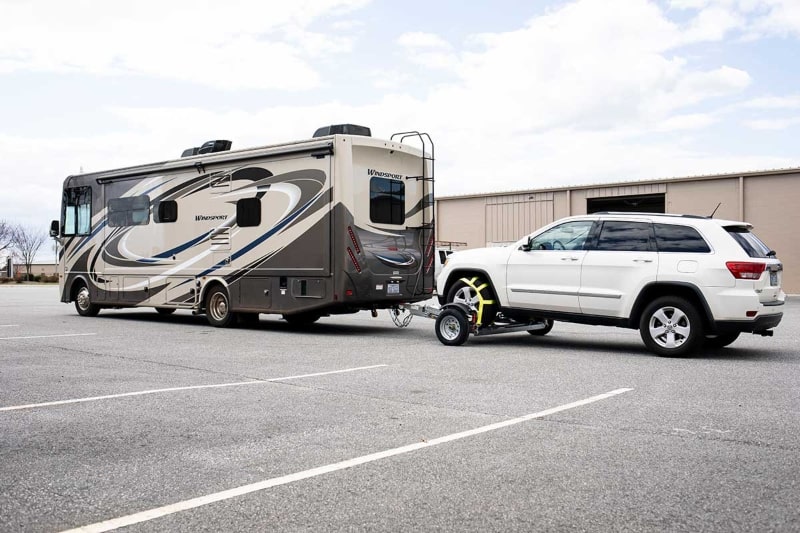
Above, we listed how to determine your tow capacity and several things that go into it. While that may seem scary, it’s just addition and subtraction. Don’t worry; you won’t have to find the square root of anything.
1. RV Size
Size matters—mostly. The engine matters even more. Larger RVs can typically tow more, but that’s not always the case. The towing capabilities of diesel and gas engines are drastically different. Gassers are limited to 5,000 to 10,000 lbs, while diesel motorhomes can go up to 20,000 lbs.
2. OCCC or CCC
As seen in the walkthrough above, the Occupant Cargo Carrying Capacity is a major factor in calculating your tow capacity.
3. GVWR
Gross Vehicle Weight Rating is one of the primary weight numbers factored into determining your tow capacity. It’s the maximum weight your RV can safely hold inside the motorhome. Traveling overweight can make you unstable, and insurance companies will refuse to cover you for an accident on the road if you’re overweight.
4. GCWR
Gross Combined Weight Rating (GCWR) equals the tow rating by taking the weight difference between the GCWR and the GVWR. Of course, things change when you start fiddling with storage, water, passenger, propane, etc. weight.
5. GAWR
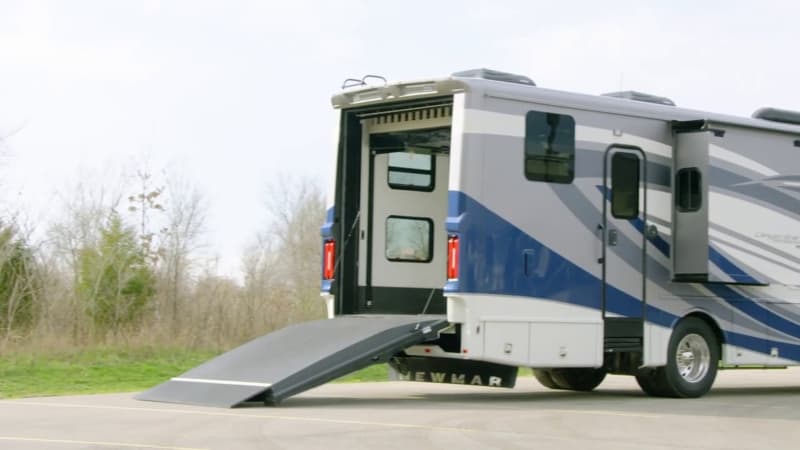
The Gross Axle Weight Rating applies to individual axles on a Class A Motorhome. That’s because a front axle may have a lower rating than the rear axle. You can’t exceed the maximum weight on each axle. This is especially important if you’re using a toy hauler motorhome.
6. Engine and Fuel Type
We gave this one away above, but that’s okay. These numbers are important, so it’s worth repeating. Diesel engines are all about torque. An electric vehicle is the only way to find something that wipes the floor with diesel in terms of torque.
7. Tongue Weight Rating
The downward force that the vehicle being towed places on the hitch, whether we’re talking Goosenecks, fifth wheels, or traditional ball hitches. The weight of what you are towing cannot exceed the tongue weight rating of your Class A Motorhome. You can minimize towing sway when what you’re towing is balanced correctly.
Can a Class A Motorhome Tow a Car?
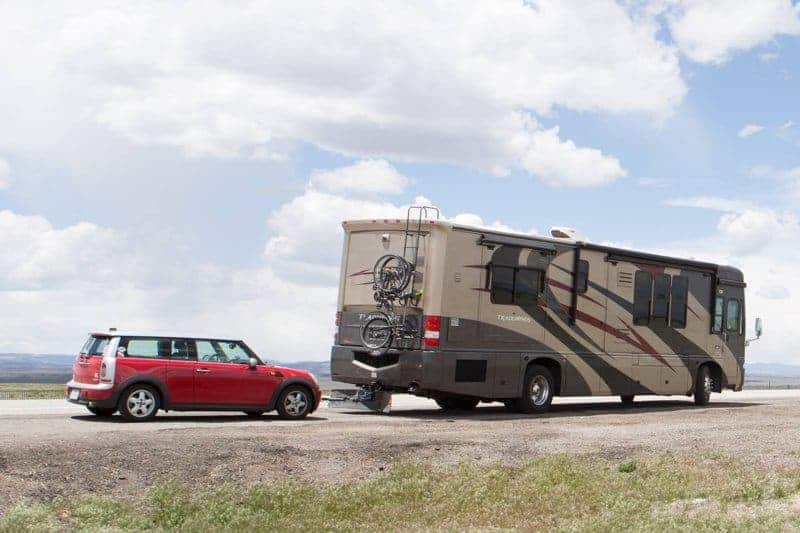
Most Class A Motorhomes can tow a vehicle, depending on the vehicle and the number you come up with by working through the weights listed above. Even smaller Class A Motorhomes with 5,000-lb towing capacities can handle something like a Mitsubishi Mirage or a Toyota Corolla, the latter weighing 2,800 lbs.
Can a Class A Motorhome Tow a Boat?
Class A Motorhome can tow a boat and other towable items. As long as the guidelines for towing capacity are followed, most Class A Motorhomes are limited only by size and weight.
What Else Can a Class A Tow?
Class A Motorhomes can tow almost everything you want on a vacation, prolonged road trip, or life on the road. You’re limited to 5,000 to 7,500 lbs with gasoline engines, but diesel engines provide you with more leeway to tow several things.
- Vehicles that weigh near or below the towing capacity
- Horse trailers
- Boats
- Travel trailers
- Cargo trailers
- Utility trailers
Can You Double-Tow with a Class A RV?
It’s considered a double-tow if your Class A Motorhome is towing a boat and a triple-tow if you have something additional hitched behind it. Class A Motorhomes are capable of doing both. The towing capacity of your rig only limits you.
What are the Laws Surrounding Towing with an RV? (Fix Info)
Unfortunately, that can get a bit hazy as every state has its own laws on towing. If you plan on triple towing, you want to triple tow. Make sure each state you will pass through allows it.
3 Methods of Towing with a Class A Motorhome
There’s always more than one way to get something done, and there are a few methods for towing you should be familiar with before you start your RV adventure.
1. Flat Tow
Flat towing uses a tow bar that attaches to a vehicle and allows it to roll behind the RV on all four tires. The only drawback to this is that front-wheel drive vehicles usually are no good for it. Manual transmissions aren’t a problem at all.
Some rear-wheel-drive and 4×4 vehicles that allow you to set the wheels to neutral are the best vehicles to flat tow.
2. Dolly Towing
Dolly towing is an effective alternative if your vehicle has FWD (Front Wheel Drive). That’s because the front two tires sit on top of the trailer, dolly-style, while only the rear tires ride on the road. Flip the car around if you have RWD (Rear Wheel Drive) as long as the front end has enough clearance.
3. Flatbed Towing
Speaking of All Wheel Drive, a good flatbed is just what you need. The entire car is elevated off the road with this method. Of course, with a flatbed, you can tow more than just a car.
Do You Need a Weight Distribution Hitch to Tow with a Class A?
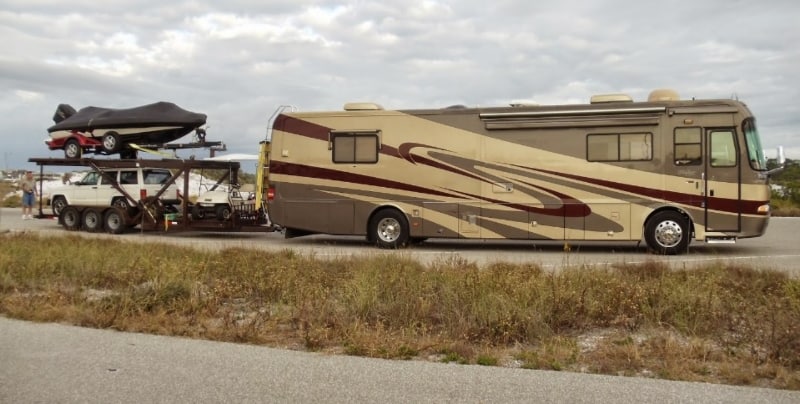
Sometimes, you might need a weight distribution hitch to tow with a Class A. A weight distribution hitch is designed for circumstances where the towed trailer or vehicle exceeds 50% of your Class A Motorhome’s GVWR.
If you have the towing capacity and you’re going to tow something that exceeds 50%, you will need a weight distribution hitch for safety and maneuverability. Generally, it’s also safer and an easier towing experience.
Is it Worth it to Tow Behind a Class A RV?
That depends on whether towing something behind a Class A RV is worth it. If you’re going somewhere for a day or two, maybe not. If you’re going on vacation and you will be gone from home for a while, it’s a good idea to take your car with you. The same holds if you live in your Class A Motorhome.
Think about it like this—once you park your 30,000-lb monster at a campground, do you really want to haul it back out to get a Slurpee at a Tom Thumb convenience store? You’ll want your car for that.
Class A Motorhomes That Can Tow 15,000 lbs.
As aforementioned, Class A Motorhomes can tow between 5,000 and 20,000 lbs. There are exceptions to the rules, but 95% of the time, this is what you will find on the market.
1. Thor Motor Coach Tuscany 45MX
Pros and Cons:
✅ Exceptional living space and counter space throughout
⛔ Bathroom ceilings are a little on the low side for 6’ + individuals
- Engine: Cummins ISL 8.9L
- Chassis: Freightliner
- Length: 44’ 10”
- GVWR: 46,000lbs
- Tow Capacity: 15,000 lbs
- Sleep: 7
With the Thor Motorcoach Tuscany 45MX, you won’t need to worry much about what you can and cannot tow. You can haul the average cabin cruiser boat behind this bad boy.
That’s not to mention the incredible space inside Tuscany. It’s like walking into a spacious condo with tan and cream interior aesthetics offset by stainless steel and pale, grey wood patterns.
2. Forest River Berkshire XLT 45E
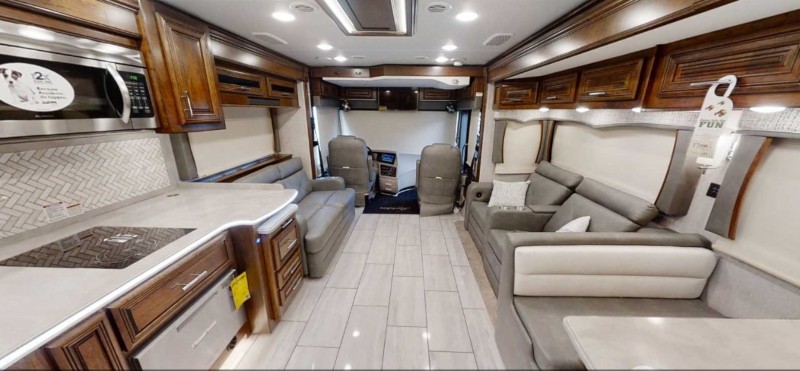
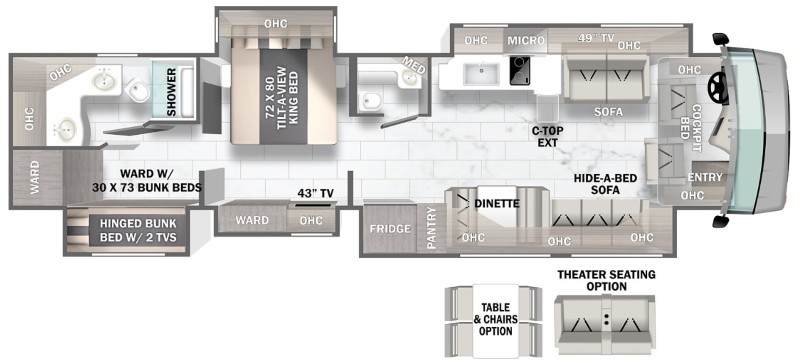
Pros and Cons:
✅ Mirror-shine, stone-tile flooring and solid-surface countertops
⛔ TV is kind of in your face, directly above the kitchen countertop prep area
- Engine: Cummins ISL 450HP
- Chassis: Freightliner XCR
- Length: 44’ 11”
- GVWR: 47,000lbs
- Tow Capacity: 15,000 lbs
- Sleep: 9
The Forest River Berkshire XLT 45E is a monstrous house on wheels that is just a shade longer than the above-listed Tuscany and has all the same amenities, including a 15,000-lb tow capacity. The interior is a light gray/tan that seamlessly mingles with a dark mahogany aesthetic.
It sleeps 9 and can haul a travel trailer large enough to sleep an additional 10. What’s also great about this diesel-pusher motorhome is that the rear bunk space can become another wardrobe or pet palace once the kids leave.
3. Entegra Anthem 44D
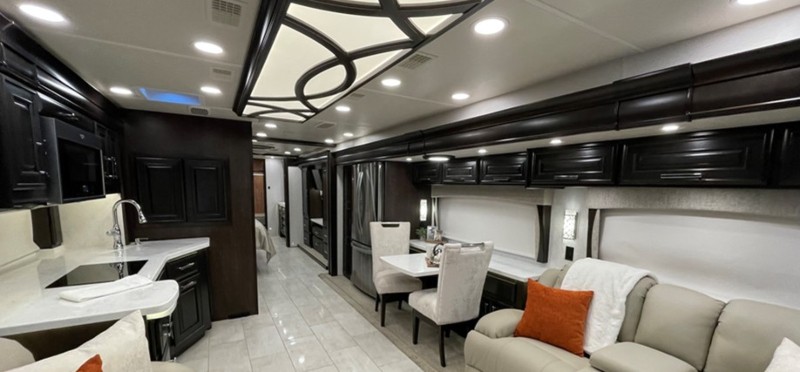
Pros and Cons:
✅ Premium leather Crown and Compass Furniture
⛔ The half bathroom can be a bit tight
- Engine: Cummins L9 Turbocharged 450HP
- Chassis: Spartan K2 Raised-Rail
- Length: 44’ 11”
- GVWR: 52,000lbs
- Tow Capacity: 15,000 lbs
- Sleep: 10
The Entegra Anthem 44D is a luxury diesel pusher and a smart device aficionado’s dream. Anywhere you go inside and outside the motorhome, there’s a USB port for charging and connecting various devices.
Everything is automated, even the reclining options on the theater seating. Since it can tow 15,000 lbs, you’re free to tow a luxury travel trailer along for the ride.
4. Newmar King Aire 4596
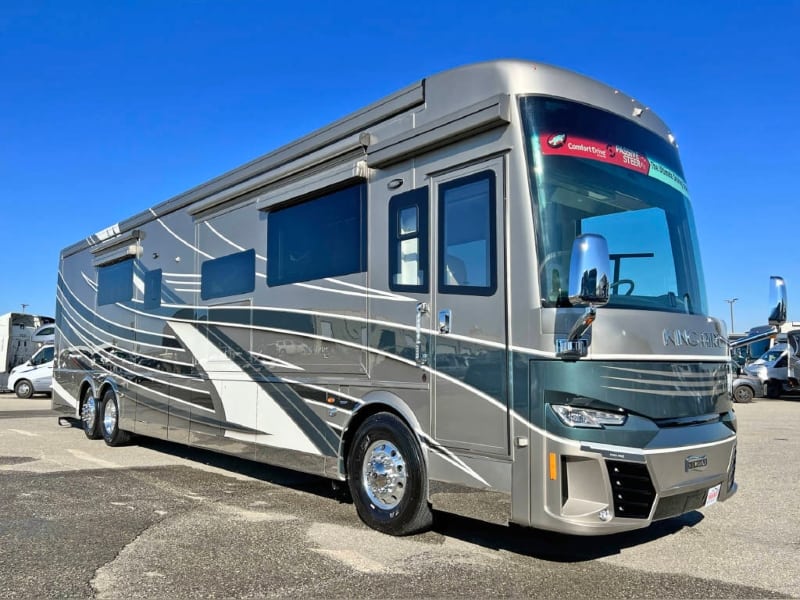
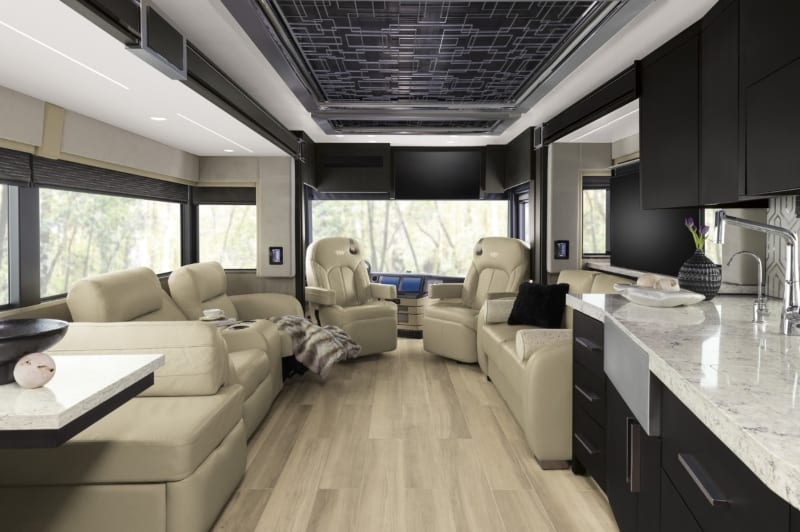
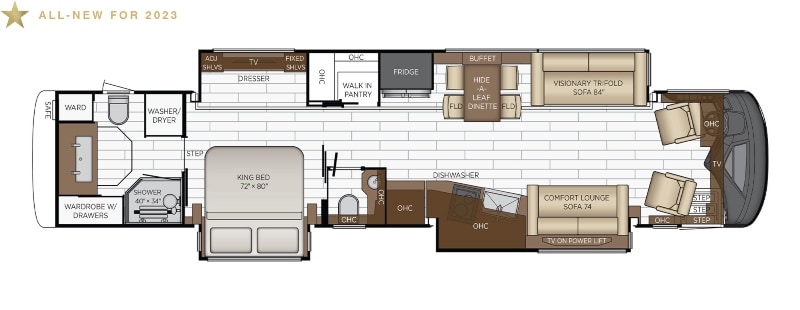
Pros and Cons:
✅ One of the best-looking interiors on the market
⛔ The TV is located behind the passenger couch
- Engine: Cummins X15 605HP
- Chassis: Spartan K2 Raised-Rail
- Length: 44’ 11”
- GVWR: 54,000lbs
- Tow Capacity: 20,000 lbs
- Sleep: 10
You won’t find a Newmar King Aire 4596, or one of the remaining three floorplans, for an MSRP lower than a million bucks. But, if you have the money, this rolling kingdom is worth every penny.
Newmar focuses on extravagant features both inside and out. The luxury aesthetic is combined with smart home-like innovations, with tons of cabinetry and fully automated blinds, a drop-down TV, and fully integrated, invisible AC and heating vents.
You’ll also love the new front and rear cap styling and other exterior innovations they made for 2023.
5. American Eagle 45E
Pros and Cons:
✅ Smartphone control with a fully integrated, multiplex electric control system
⛔ In travel mode, the spacing gets tight around the kitchen island
- Engine: Cummins ISX15 605HP
- Chassis: Liberty Bridge Freightliner
- Length: 45’
- GVWR: 54,000 lbs
- Tow Capacity: 20,000 lbs
- Sleep: 4
Another luxury on wheels, the American Eagle 45E is an impressive Class A Motorhome with enough interior space to feature a kitchen counter island. The shiny white and grey interior aesthetic is sheer eye candy, resplendent and futuristic simultaneously.
American Eagle used subtle curves in their designs, spotted in nearly every interior piece, from furniture to the crown molding hanging over mirror-shine cabinetry. It’s everything you could want in brick-and-stick homes with comfort with vivacious style.
Reasons to Tow with a Class A RV
Once these RVs are parked, there is a reason you want to bring along another vehicle. These are monster motorhomes, and trips to the convenience store, downtown, or a shopping center are simply out of the question.
As luxurious as they are, there are always reasons to tow, including vehicles, ATVs, boats, horse trailers, utility trailers, cargo trailers, and extra travel trailers. Why go to the outdoor party when you can bring it with you?
Reasons You Shouldn’t Tow with a Class A RV
The first and most obvious reason is if the thing you want to tow weighs more than you can safely tow, according to the specs on the Class A Motorhome. But it doesn’t end there.
- Tow packages can get expensive if you need them
- Your turn radius is already wide, and it grows exponentially when towing
- You have to hook and unhook
- It’s more difficult to make that initial parking job when you arrive
- Speed and length limitations in every state
- Braking is more difficult and longer
Final Thoughts
Depending on the Class A Motorhome, you can tow between 5,000 and 20,000 lbs. You can tow a small car, even with a mid-size Class A RV. Towing is almost necessary, considering the severe limitations of in-town driving in a Class A Motorhome.
These are enormous vehicles, which means you have enormous weights to calculate. Towing capacity doesn’t always remain the same when you start throwing heavy storage items onboard, filling up your tanks, and loading your Class A up with people.
There are a lot of factors that go into choosing the right Class of Motorhome. Fortunately, a Class A’s towing capacity isn’t one of them because most of them are more than up to the task.
About the Author:
Thomas Godwin is a full-time freelance writer with a BFA in Creative Writing, a U.S. Marine, and an avid outdoorsman.
When he’s not writing, he’s raising chickens and Appleyard ducks. Thomas also constructs teardrop campers (attempting to anyway) and kayaks the Blackwater River with his wife, two daughters, and his Dobermans.


